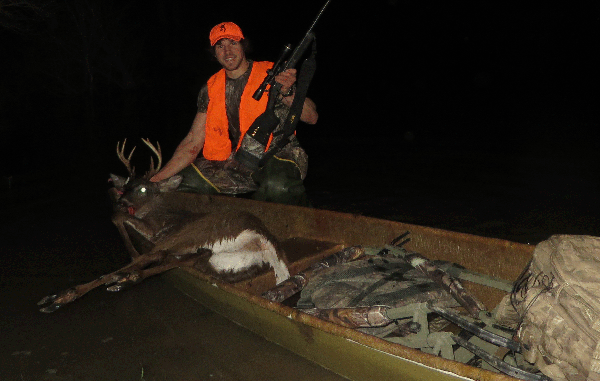
Apex Predator’s late season tip to surprise nocturnal swamp bucks
My dad grew up hunting the flooded swamps around Lac Des Allemands. He enjoyed deer hunting, but chasing those swamp bucks was too frustrating after the rut, so he stuck with his favorite type of hunting in January, which was blasting birds.
Almost magically, his love for duck hunting those deep swamps revealed how that wily old nocturnal buck can possibly be out-slicked for a change.
So how do you down a big swamp buck late in the season after hunting pressure has turned the deer nocturnal?
Easy: Find the deer’s defense system and use it to your advantage.
Just as many people use guard dogs to alert them of intruders, a smart swamp buck uses the same principle by bedding practically all day near noisy ducks that take off quaking loudly at the first sign of danger.
It only takes one tiny swamp mound for a big ol’ daddy deer to hide on. As soon as danger enters the buck’s turf, those ducks will alert the deer and send him bounding to a new swamp mound, never to be seen again.
Every year while paddling the pirogue to a duck hole, my dad would jump the biggest buck seen for the season near a thick flock of mallards – but the buck would only be jumped once from each particular spot.
After seeing a buck near the same place multiple years in a row, Dad’s motivation to down the elusive king of the swamp was reignited, but he patiently waited for the correct conditions the following year.
He avoided hunting a particular duck hole all season, waiting for perfect wind and cold, cloudy, sleeting conditions to enact his plan on a January morning in 1979.
After feeding on the swamp ridges all night, a huge mature 9-pointer crept through at daybreak to the safety of his swamp mound near his green-headed friends. Unfortunately for Mr. Buck, my dad had already crept through the swamp in the middle of the night and was waiting near the same mound.
Of all the nice deer my dad killed, that buck was the only one he ever mounted because it took him practically his whole life to figure out how to take it down in the very swamps where he spent his childhood.
For this duck strategy to work, arrive super-early for morning hunts. For evening hunts, set up as close to the ducks as possible without spooking them. These birds see practically everything, especially hunter orange. The buck probably won’t budge until dusk, so being close is important if you want to glimpse the deer before the light fades.
Don’t get frustrated if you hunt the rest of the season at a particular location where the buck was jumped and the deer never returns. Instead, wait until the next year to head back there — when the buck forgets all about you and is much bigger.
A few years ago after hunting hard on Mississippi public-land all season, I finally saw a nice 8-pointer one morning. The buck made a bee line directly toward me, but buck-fever took hold. Instead of waiting for the deer to look the other way, I nervously cocked the hammer back on my muzzleloader and repositioned the gun since the deer was on my non-shooting side. That buck heard that click and spotted my movement, bolting away in less than a second. My hard work all season to down my first Mississippi buck had culminated with complete failure.
The deer ran back into a flooded section of woods where I had never before ventured. Suddenly, I heard all kinds of ducks take off near a small levee. Upon further investigation, I found his bedding area near the ducks.
Two years later, I was back in St. Catherine’s Creek NWR and I knew just where to hunt. It was a cloudy December evening, and I was considering getting down with less than 10 minutes of shooting time remaining.
The darkness made it impossible to spot legal antler size unless a buck walked perfectly down my levee trail 15-yards away in the open. What were the odds of that?
I started lowering my hunting bag, when suddenly I heard dozens of nearby mallards get spooked. Could using my dad’s duck theory actually work for me? I sat tight a while longer.
Sure enough, a big doe stepped out from the water and onto the old overgrown levee. A big figure slowly trotted behind in the knee deep water. The deer was really close, but I couldn’t see anything except a large silhouette and ripples.
But my heart leapt out of my chest once I glimpsed a large white rack just 15 yards away. With just two minutes of shooting time remaining, my smoke-pole blasted and I downed the 5 1/2-year-old, heavy-horned 6-point buck that sported a 16-inch inside spread.
Two weeks later, a similar scenario played out. I paddled into the flooded woods with my pirogue and set up very close to a thicket surrounded by duck ponds in R.K. Yancey WMA. With less than 30 minutes of hunting time remaining, a bunch of mallards and woodies were disturbed. I was facing the opposite direction, so I turned in my tree stand to check out the commotion.
Minutes later, an 11-pointer magically appeared next to the trail I walked in on. Before he spooked, my Marlin .444 hammered the buck down, leaving me tagged out on the best deer season of my life. (The video of these two bucks going down can be found in last year’s article by clicking here.
And the 2012 7-pointer I rattled in (featured in the bonus section of the video) was killed after he scared two wood ducks from the slough he was traveling.
Without knowing about this duck tactic, I may have never hunted that Mississippi location, or I might have continued to climb down on that hunt. My Yancey buck would’ve probably sniffed my trail and turned around unnoticed back into his thicket while I faced the other direction.
Thanks to the ducks, those racks now hang on my wall.
As a kid I always enjoyed the game “Duck, Duck, Goose.” Nowadays, when the woods become flooded in the late season, I play the game “Duck, Duck, Buck.”


